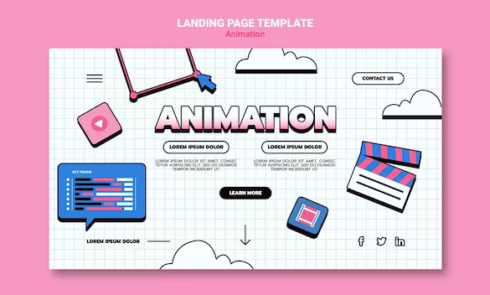Say goodbye to static PDFs and hello to interactive reports—the modern solution to engaging your audience effectively. Annual reports, industry insights, news updates, marketing analyses—these are all vital pieces of long-form content that businesses and organizations need to share. However, the problem lies in their format: the outdated PDF. Shockingly, a 2014 report from The World Bank found that almost a third of their reports were never downloaded, resulting in critical information missing its intended audience of stakeholders, investors, and shareholders.
The solution? Opt for interactive presentations. With accessible web creation tools that require no coding knowledge or substantial budgets, creating engaging web content, like interactive presentations, has become simpler than ever. Let’s explore why interactive presentations are superior and dive into some concrete examples that demonstrate their effectiveness.
Understanding Interactive Reports
An interactive report isn’t just your typical, dry document—it’s a dynamic piece of content that breathes life into information. By incorporating various interactive elements such as videos, animations, scrollytelling, data visualizations, vibrant colors, typography, and clickable hotspots, these reports transform from mundane to captivating digital narratives.
The evolution of annual reports showcases the power of interactivity. Once seen as dull reads, it now stand as anticipated brand events. They serve not only to showcase achievements but also to forge connections and humanize brands.
Beyond boosting engagement and elevating brand presence, interactive reports leave a lasting impression. According to a study by content creation platform Turtl, audiences spend 73% more time engaging with interactive reports compared to static PDFs—an undeniable testament to their effectiveness.
Effective Design Strategies for Crafting Interactive Reports

Creating an interactive report offers a multitude of design techniques to explore. The selection of these techniques hinges on the narrative you aim to present and the brand identity you wish to embody. Below are several top-notch design strategies to consider integrating into your interactive report.
Scroll Animations
- Scroll animations have become widely embraced in interactive report design, injecting dynamism into otherwise static content and elevating the presentation of your reports;
- Among these techniques, scroll-triggered animated charts stand out for their ability to not only animate data but also enhance comprehension of intricate information.
In the realm of data-heavy reports, where conveying complex information is paramount, data visualizations such as charts and graphs have long been valued for their capacity to simplify comprehension. However, integrating interactivity into data presentation takes this a step further. Scroll-animated charts empower readers to navigate data at their own pace, directing attention to key insights that can deepen their grasp of the material.
Scrollytelling
- Scrollytelling stands as a prominent technique in digital storytelling and visual journalism, equally impactful in the realm of interactive reports;
- This approach, blending scrolling and storytelling, crafts an engaging narrative that unfolds seamlessly as the reader scrolls.
Various scrollytelling techniques exist, spanning from parallax image and text scrolls to horizontal and video scrolls. Each method has the power to transform readers into active participants, guiding them through the content with interactive engagement.
Scroll Progress Bar
- While browsing a website or perusing an article, individuals often desire a clear indicator of their progress through the content;
- Scroll progress bars serve as effective visual cues, offering insights into the extent of the page consumed.
By infusing interactivity into these progress bars, users can enjoy an engaging visual experience as they navigate up or down a page. Such enhancements exemplify how interactivity can significantly enhance website user experience (UX).
Image Comparison Slider
- When incorporating comparison images into your interactive report, a highly effective method for enhancing interactivity is by integrating image comparison sliders;
- Placing two images alongside each other often results in the human eye being instinctively drawn to the second image, potentially overlooking details in the first.
By implementing image comparison sliders, readers can slide an arrow to gradually reveal the second image. Beyond simply adding a sleek interactive element to what would otherwise be static images, this technique ensures that both images receive equal attention. Consequently, the intended message you aim to convey is communicated more effectively.
Clickable Image Hotspots
- Clickable image hotspots are commonly utilized in maps, diagrams, and product photographs, serving as effective tools for incorporating supplementary information such as text, images, or links without overshadowing the visual content;
- This functionality translates seamlessly into interactive reports.
For those seeking to introduce straightforward interactive elements into their reports, clickable image hotspots prove to be a reliable choice. They empower readers to navigate through the content at their own pace, enabling them to select the desired level of detail they wish to explore.
Carousel
- When confronted with extensive blocks of text in your interactive report, employing an image carousel offers an excellent solution to alleviate the monotony;
- These carousels not only efficiently showcase multiple images without excessive bandwidth usage but also introduce subtle interactivity, enabling readers to click, scroll, and explore at their leisure.
Examples of Interactive Reports Done Right

Now that we understand some effective design techniques for interactive reports, let’s see them in practical application with real-world examples.
ServiceNow
ServiceNow, an American software company, showcases various interactive design strategies in their report titled “The Sustainability Advantage.” This serves as a prime example of how corporate reports can be elevated into visually stimulating and dynamic digital narratives through the integration of creative design and interactive features.
Focusing on the significance of environmental, social, and corporate frameworks, the report employs innovative scrollytelling techniques to transform what might have been a conventional and potentially dull report into a captivating narrative.
As readers scroll through the content, interactive design elements come to life in diverse ways. The narrative commences with animated illustrations, immediately signaling to the reader that this is not your typical business document. Interactive charts and graphs direct the reader’s attention to key data points, improving comprehension and maintaining engagement.
To prevent overwhelming readers with extensive text or data, the content is interspersed with vibrant images, animated illustrations, and interactive text boxes. This approach ensures that readers remain engaged and no crucial information is overlooked.
World Heart Federation
The World Heart Federation, a leading organization in cardiovascular health, presents an interactive report that employs a range of digital design techniques to underscore the importance of their mission and maintain reader engagement.
The report begins with a poignant video featuring WHF members, instantly humanizing the organization and emphasizing the widespread relevance of heart health. Scrollytelling is then utilized effectively, featuring bold typography to highlight impactful statements and thought-provoking questions.
An unexpected transition to horizontal scrolling early in the report adds an element of surprise, capturing the reader’s interest and encouraging them to explore further. Colorful images and illustrated text boxes interspersed throughout the text break up the content, ensuring that this comprehensive report remains accessible and easy to digest.
The alternating use of vertical and horizontal scrolling is a notable feature of this interactive report, offering readers a unique and engaging experience. Despite addressing serious issues in-depth, the innovative interactive design and visually appealing aesthetics make it a pleasure to navigate and read.
The Unsustainability Report
The report addresses the challenges hindering efforts to reduce our climate footprint, highlighting a critical issue. Despite the seriousness of the subject matter, the report serves as a prime example of how integrating interactivity can enhance the presentation of substantial content without diminishing its importance.
With its extensive data-packed content, the report employs various interactive elements to prevent overwhelming the reader. Scrollytelling is effectively utilized, accompanied by the strategic inclusion of colorful videos that lend a cinematic quality to what could otherwise be a dry, data-centric document.
In line with the best practices for handling data-heavy content, the report features numerous animated charts. These not only break up the text but also emphasize key research findings. By encapsulating crucial data within animated charts, readers can easily grasp essential information without getting bogged down in extraneous details.
Given the text and data-intensive nature of the report, accordions are also employed. These accordions allow for the concealment of large amounts of content under clickable headings, which, when expanded, reveal additional text. This approach effectively condenses content while introducing interactivity, ensuring that non-essential information can be included without overwhelming the report’s appearance.
Boston University Annual Report
While interactive reports have surged in popularity in recent years, some organizations were quick to recognize their potential. Boston University stands out as one such entity, and their 2016 annual report serves as a stellar example of the captivating, polished, and intriguing nature of interactive reports.
The report commences with a bold inquiry: “Why isn’t a billion dollars enough?”, adorned with vibrant font and accompanied by dynamic, rotating images. As readers scroll, additional thought-provoking questions emerge, such as “Why should we break bread with terrorists?” and “Why can’t we get a straight answer on prostate cancer?”.
Rather than offering immediate answers, the report integrates clickable hotspots labeled “Read the answer” or “Find out why”. This not only piques reader curiosity and adds interactivity but also enables them to download detailed answers by clicking on the hotspots. Similar to accordions, this approach efficiently delivers substantial information without overwhelming the report.
Videos are also incorporated, concealed behind clickable hotspots, affording readers the choice to watch at their discretion. By presenting their annual report as a series of engaging questions, this interactive presentation underscores Boston University’s standing as an esteemed institution of learning and a source of answers. Their adept use of interactivity solidifies their position as a trailblazer in thought leadership.
Spotify
Spotify, the music streaming platform, unleashed its vibrant and imaginative 2021 advertising roundup. This interactive report delves into how Gen Z and millennials are shaping audio streaming and culture. Upon landing on the page, visitors are presented with the option to either download the report or click “explore,” initiating an immersive digital journey.
The experience kicks off with electronic music playing in the background, creating an enchanting atmosphere. Animated cubes, adorned with illustrations of people engrossed in music, dance and twirl in a kaleidoscope of pastel-colored geometric space. As users scroll, the cubes continue their mesmerizing dance, unveiling new scenes accompanied by different music tracks each time.
Each scene features clickable hotspots labeled “explore,” which unveil additional colorful geometric landscapes containing more ‘explore’ buttons. Clicking these buttons reveals detailed insights about consumers and music, while encouraging users to download the complete report for further exploration. These hidden details optimize space for creative design elements, allowing viewers to focus on the captivating visuals.
In summary, this interactive piece of multimedia is truly impressive. Bursting with color, motion, animations, and audio, it provides a multi-sensory experience. With control over the scrolling process, viewers can leisurely absorb the content at their own pace.
Conclusion
Interactive reports provide a refreshing departure from conventional reporting methods and offer a more engaging, memorable option. They have the potential to transform data-heavy, dull documents into creative, riveting experiences that captivate audiences and foster connections. As technology evolves, the abilities and applications of interactive reports will only grow, firmly establishing them as a powerful tool in the digital age.

